Artificial Intelligence in Workplace: Opportunities and Challenges
VerifiedAdded on 2022/10/06
|5
|1505
|20
Essay
AI Summary
This essay examines the multifaceted impact of Artificial Intelligence (AI) on the modern workplace. It explores the dual nature of AI, highlighting both its potential to enhance human jobs through increased efficiency and its perceived threat of job displacement. The essay delves into specific examples across various sectors, including manufacturing, healthcare, and cyber security, illustrating how AI can improve accuracy, reduce costs, and streamline processes. It also addresses the debate surrounding AI's role, arguing that AI primarily serves as a tool to augment human capabilities rather than replace them. The essay provides evidence from China's supply chain management, showcasing the rise of new opportunities in AI-related fields. It also emphasizes the importance of 'Human in the Loop' workflows to maintain quality and innovation. The essay concludes by suggesting that AI adoption creates new economic growth and innovative ideas, ultimately benefiting society.
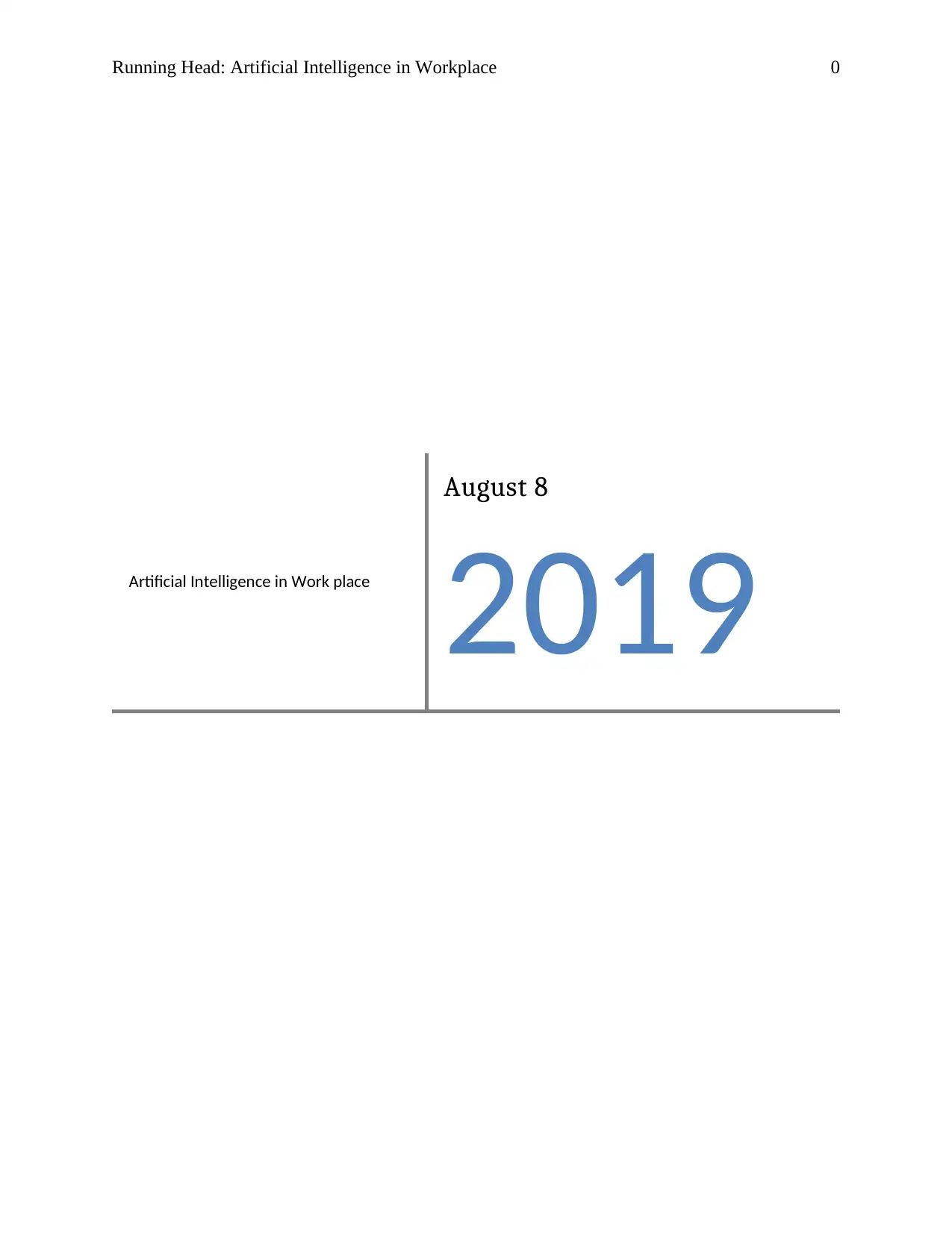
Running Head: Artificial Intelligence in Workplace 0
Artificial Intelligence in Work place
August 8
2019
Artificial Intelligence in Work place
August 8
2019
Paraphrase This Document
Need a fresh take? Get an instant paraphrase of this document with our AI Paraphraser
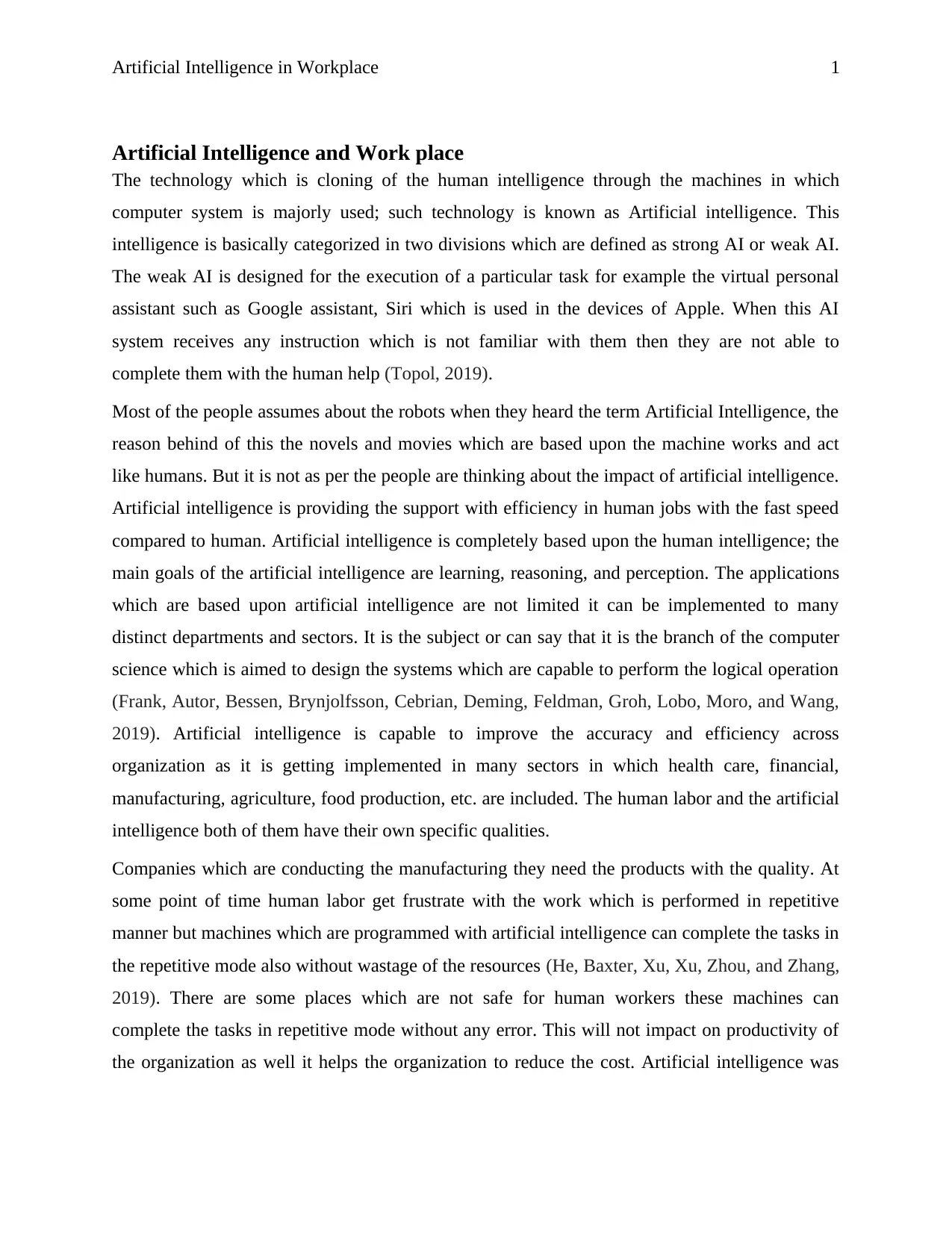
Artificial Intelligence in Workplace 1
Artificial Intelligence and Work place
The technology which is cloning of the human intelligence through the machines in which
computer system is majorly used; such technology is known as Artificial intelligence. This
intelligence is basically categorized in two divisions which are defined as strong AI or weak AI.
The weak AI is designed for the execution of a particular task for example the virtual personal
assistant such as Google assistant, Siri which is used in the devices of Apple. When this AI
system receives any instruction which is not familiar with them then they are not able to
complete them with the human help (Topol, 2019).
Most of the people assumes about the robots when they heard the term Artificial Intelligence, the
reason behind of this the novels and movies which are based upon the machine works and act
like humans. But it is not as per the people are thinking about the impact of artificial intelligence.
Artificial intelligence is providing the support with efficiency in human jobs with the fast speed
compared to human. Artificial intelligence is completely based upon the human intelligence; the
main goals of the artificial intelligence are learning, reasoning, and perception. The applications
which are based upon artificial intelligence are not limited it can be implemented to many
distinct departments and sectors. It is the subject or can say that it is the branch of the computer
science which is aimed to design the systems which are capable to perform the logical operation
(Frank, Autor, Bessen, Brynjolfsson, Cebrian, Deming, Feldman, Groh, Lobo, Moro, and Wang,
2019). Artificial intelligence is capable to improve the accuracy and efficiency across
organization as it is getting implemented in many sectors in which health care, financial,
manufacturing, agriculture, food production, etc. are included. The human labor and the artificial
intelligence both of them have their own specific qualities.
Companies which are conducting the manufacturing they need the products with the quality. At
some point of time human labor get frustrate with the work which is performed in repetitive
manner but machines which are programmed with artificial intelligence can complete the tasks in
the repetitive mode also without wastage of the resources (He, Baxter, Xu, Xu, Zhou, and Zhang,
2019). There are some places which are not safe for human workers these machines can
complete the tasks in repetitive mode without any error. This will not impact on productivity of
the organization as well it helps the organization to reduce the cost. Artificial intelligence was
Artificial Intelligence and Work place
The technology which is cloning of the human intelligence through the machines in which
computer system is majorly used; such technology is known as Artificial intelligence. This
intelligence is basically categorized in two divisions which are defined as strong AI or weak AI.
The weak AI is designed for the execution of a particular task for example the virtual personal
assistant such as Google assistant, Siri which is used in the devices of Apple. When this AI
system receives any instruction which is not familiar with them then they are not able to
complete them with the human help (Topol, 2019).
Most of the people assumes about the robots when they heard the term Artificial Intelligence, the
reason behind of this the novels and movies which are based upon the machine works and act
like humans. But it is not as per the people are thinking about the impact of artificial intelligence.
Artificial intelligence is providing the support with efficiency in human jobs with the fast speed
compared to human. Artificial intelligence is completely based upon the human intelligence; the
main goals of the artificial intelligence are learning, reasoning, and perception. The applications
which are based upon artificial intelligence are not limited it can be implemented to many
distinct departments and sectors. It is the subject or can say that it is the branch of the computer
science which is aimed to design the systems which are capable to perform the logical operation
(Frank, Autor, Bessen, Brynjolfsson, Cebrian, Deming, Feldman, Groh, Lobo, Moro, and Wang,
2019). Artificial intelligence is capable to improve the accuracy and efficiency across
organization as it is getting implemented in many sectors in which health care, financial,
manufacturing, agriculture, food production, etc. are included. The human labor and the artificial
intelligence both of them have their own specific qualities.
Companies which are conducting the manufacturing they need the products with the quality. At
some point of time human labor get frustrate with the work which is performed in repetitive
manner but machines which are programmed with artificial intelligence can complete the tasks in
the repetitive mode also without wastage of the resources (He, Baxter, Xu, Xu, Zhou, and Zhang,
2019). There are some places which are not safe for human workers these machines can
complete the tasks in repetitive mode without any error. This will not impact on productivity of
the organization as well it helps the organization to reduce the cost. Artificial intelligence was
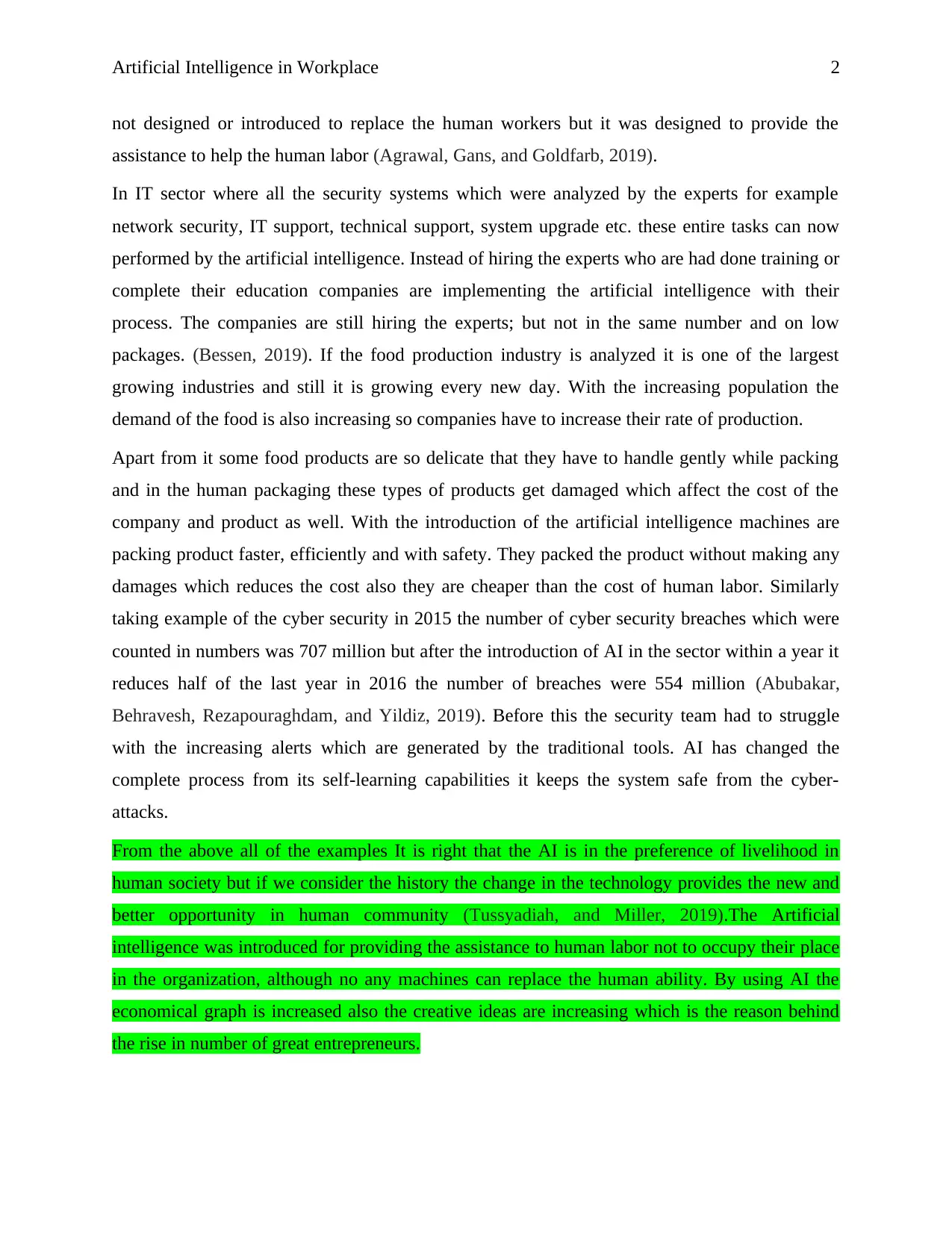
Artificial Intelligence in Workplace 2
not designed or introduced to replace the human workers but it was designed to provide the
assistance to help the human labor (Agrawal, Gans, and Goldfarb, 2019).
In IT sector where all the security systems which were analyzed by the experts for example
network security, IT support, technical support, system upgrade etc. these entire tasks can now
performed by the artificial intelligence. Instead of hiring the experts who are had done training or
complete their education companies are implementing the artificial intelligence with their
process. The companies are still hiring the experts; but not in the same number and on low
packages. (Bessen, 2019). If the food production industry is analyzed it is one of the largest
growing industries and still it is growing every new day. With the increasing population the
demand of the food is also increasing so companies have to increase their rate of production.
Apart from it some food products are so delicate that they have to handle gently while packing
and in the human packaging these types of products get damaged which affect the cost of the
company and product as well. With the introduction of the artificial intelligence machines are
packing product faster, efficiently and with safety. They packed the product without making any
damages which reduces the cost also they are cheaper than the cost of human labor. Similarly
taking example of the cyber security in 2015 the number of cyber security breaches which were
counted in numbers was 707 million but after the introduction of AI in the sector within a year it
reduces half of the last year in 2016 the number of breaches were 554 million (Abubakar,
Behravesh, Rezapouraghdam, and Yildiz, 2019). Before this the security team had to struggle
with the increasing alerts which are generated by the traditional tools. AI has changed the
complete process from its self-learning capabilities it keeps the system safe from the cyber-
attacks.
From the above all of the examples It is right that the AI is in the preference of livelihood in
human society but if we consider the history the change in the technology provides the new and
better opportunity in human community (Tussyadiah, and Miller, 2019).The Artificial
intelligence was introduced for providing the assistance to human labor not to occupy their place
in the organization, although no any machines can replace the human ability. By using AI the
economical graph is increased also the creative ideas are increasing which is the reason behind
the rise in number of great entrepreneurs.
not designed or introduced to replace the human workers but it was designed to provide the
assistance to help the human labor (Agrawal, Gans, and Goldfarb, 2019).
In IT sector where all the security systems which were analyzed by the experts for example
network security, IT support, technical support, system upgrade etc. these entire tasks can now
performed by the artificial intelligence. Instead of hiring the experts who are had done training or
complete their education companies are implementing the artificial intelligence with their
process. The companies are still hiring the experts; but not in the same number and on low
packages. (Bessen, 2019). If the food production industry is analyzed it is one of the largest
growing industries and still it is growing every new day. With the increasing population the
demand of the food is also increasing so companies have to increase their rate of production.
Apart from it some food products are so delicate that they have to handle gently while packing
and in the human packaging these types of products get damaged which affect the cost of the
company and product as well. With the introduction of the artificial intelligence machines are
packing product faster, efficiently and with safety. They packed the product without making any
damages which reduces the cost also they are cheaper than the cost of human labor. Similarly
taking example of the cyber security in 2015 the number of cyber security breaches which were
counted in numbers was 707 million but after the introduction of AI in the sector within a year it
reduces half of the last year in 2016 the number of breaches were 554 million (Abubakar,
Behravesh, Rezapouraghdam, and Yildiz, 2019). Before this the security team had to struggle
with the increasing alerts which are generated by the traditional tools. AI has changed the
complete process from its self-learning capabilities it keeps the system safe from the cyber-
attacks.
From the above all of the examples It is right that the AI is in the preference of livelihood in
human society but if we consider the history the change in the technology provides the new and
better opportunity in human community (Tussyadiah, and Miller, 2019).The Artificial
intelligence was introduced for providing the assistance to human labor not to occupy their place
in the organization, although no any machines can replace the human ability. By using AI the
economical graph is increased also the creative ideas are increasing which is the reason behind
the rise in number of great entrepreneurs.
⊘ This is a preview!⊘
Do you want full access?
Subscribe today to unlock all pages.

Trusted by 1+ million students worldwide
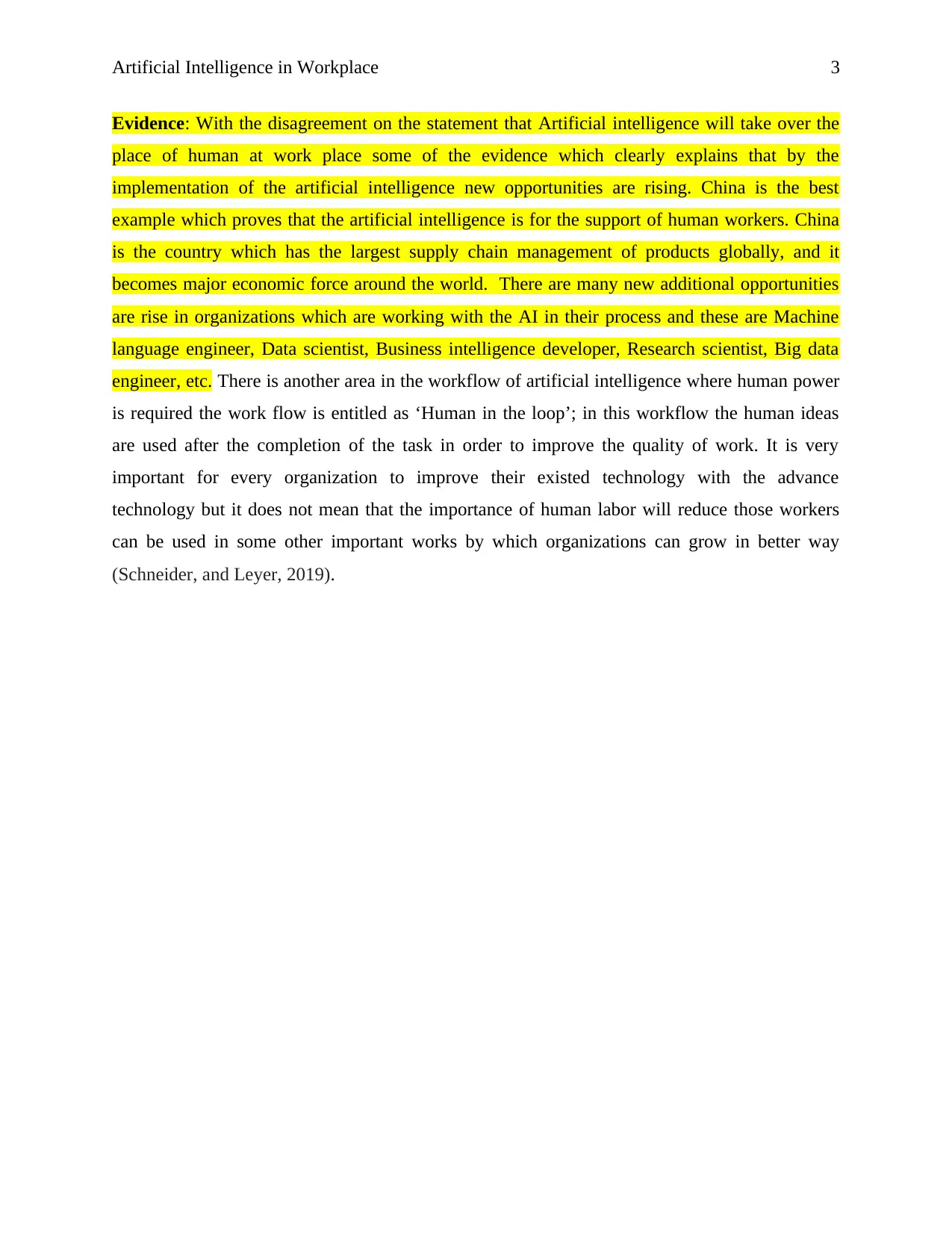
Artificial Intelligence in Workplace 3
Evidence: With the disagreement on the statement that Artificial intelligence will take over the
place of human at work place some of the evidence which clearly explains that by the
implementation of the artificial intelligence new opportunities are rising. China is the best
example which proves that the artificial intelligence is for the support of human workers. China
is the country which has the largest supply chain management of products globally, and it
becomes major economic force around the world. There are many new additional opportunities
are rise in organizations which are working with the AI in their process and these are Machine
language engineer, Data scientist, Business intelligence developer, Research scientist, Big data
engineer, etc. There is another area in the workflow of artificial intelligence where human power
is required the work flow is entitled as ‘Human in the loop’; in this workflow the human ideas
are used after the completion of the task in order to improve the quality of work. It is very
important for every organization to improve their existed technology with the advance
technology but it does not mean that the importance of human labor will reduce those workers
can be used in some other important works by which organizations can grow in better way
(Schneider, and Leyer, 2019).
Evidence: With the disagreement on the statement that Artificial intelligence will take over the
place of human at work place some of the evidence which clearly explains that by the
implementation of the artificial intelligence new opportunities are rising. China is the best
example which proves that the artificial intelligence is for the support of human workers. China
is the country which has the largest supply chain management of products globally, and it
becomes major economic force around the world. There are many new additional opportunities
are rise in organizations which are working with the AI in their process and these are Machine
language engineer, Data scientist, Business intelligence developer, Research scientist, Big data
engineer, etc. There is another area in the workflow of artificial intelligence where human power
is required the work flow is entitled as ‘Human in the loop’; in this workflow the human ideas
are used after the completion of the task in order to improve the quality of work. It is very
important for every organization to improve their existed technology with the advance
technology but it does not mean that the importance of human labor will reduce those workers
can be used in some other important works by which organizations can grow in better way
(Schneider, and Leyer, 2019).
Paraphrase This Document
Need a fresh take? Get an instant paraphrase of this document with our AI Paraphraser
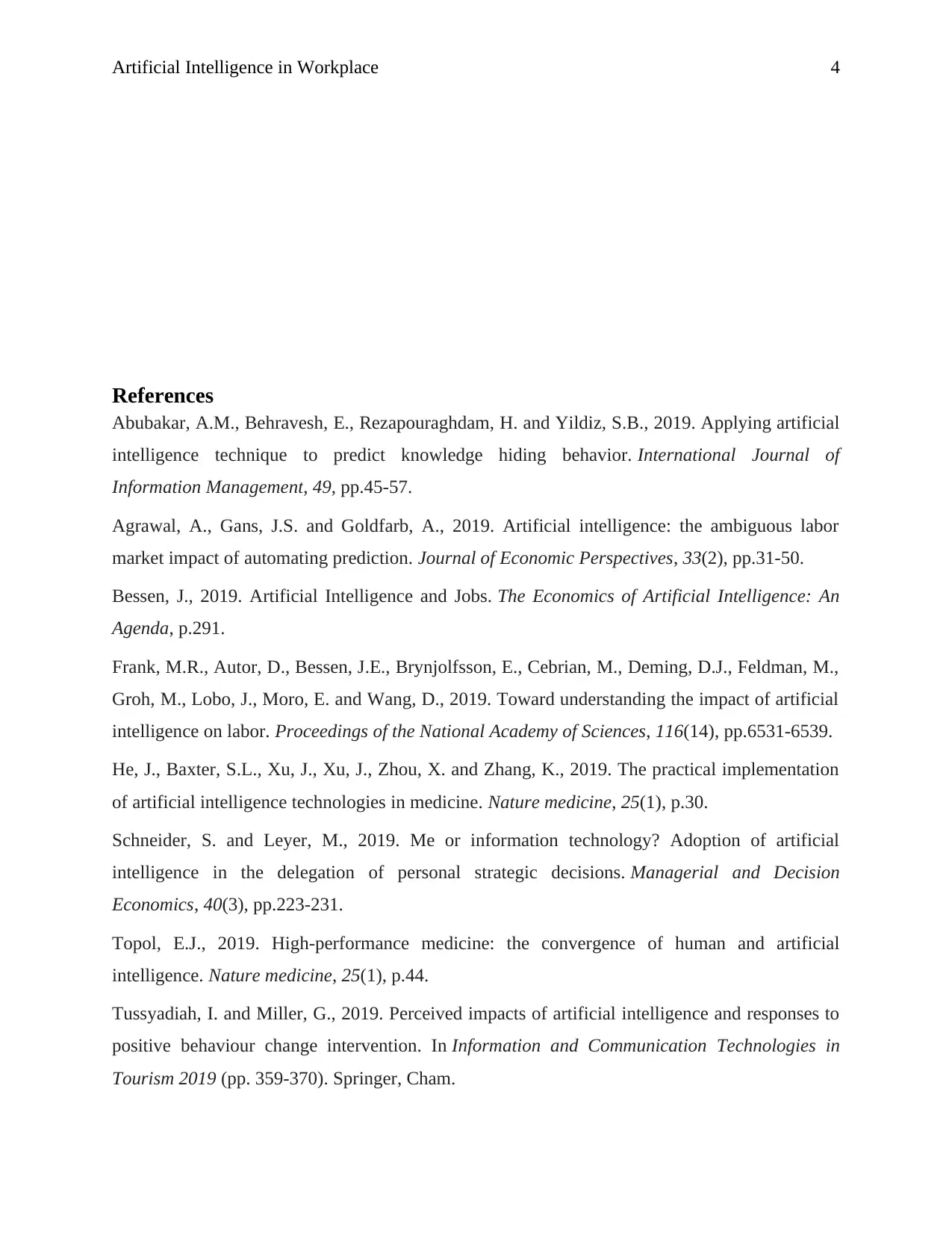
Artificial Intelligence in Workplace 4
References
Abubakar, A.M., Behravesh, E., Rezapouraghdam, H. and Yildiz, S.B., 2019. Applying artificial
intelligence technique to predict knowledge hiding behavior. International Journal of
Information Management, 49, pp.45-57.
Agrawal, A., Gans, J.S. and Goldfarb, A., 2019. Artificial intelligence: the ambiguous labor
market impact of automating prediction. Journal of Economic Perspectives, 33(2), pp.31-50.
Bessen, J., 2019. Artificial Intelligence and Jobs. The Economics of Artificial Intelligence: An
Agenda, p.291.
Frank, M.R., Autor, D., Bessen, J.E., Brynjolfsson, E., Cebrian, M., Deming, D.J., Feldman, M.,
Groh, M., Lobo, J., Moro, E. and Wang, D., 2019. Toward understanding the impact of artificial
intelligence on labor. Proceedings of the National Academy of Sciences, 116(14), pp.6531-6539.
He, J., Baxter, S.L., Xu, J., Xu, J., Zhou, X. and Zhang, K., 2019. The practical implementation
of artificial intelligence technologies in medicine. Nature medicine, 25(1), p.30.
Schneider, S. and Leyer, M., 2019. Me or information technology? Adoption of artificial
intelligence in the delegation of personal strategic decisions. Managerial and Decision
Economics, 40(3), pp.223-231.
Topol, E.J., 2019. High-performance medicine: the convergence of human and artificial
intelligence. Nature medicine, 25(1), p.44.
Tussyadiah, I. and Miller, G., 2019. Perceived impacts of artificial intelligence and responses to
positive behaviour change intervention. In Information and Communication Technologies in
Tourism 2019 (pp. 359-370). Springer, Cham.
References
Abubakar, A.M., Behravesh, E., Rezapouraghdam, H. and Yildiz, S.B., 2019. Applying artificial
intelligence technique to predict knowledge hiding behavior. International Journal of
Information Management, 49, pp.45-57.
Agrawal, A., Gans, J.S. and Goldfarb, A., 2019. Artificial intelligence: the ambiguous labor
market impact of automating prediction. Journal of Economic Perspectives, 33(2), pp.31-50.
Bessen, J., 2019. Artificial Intelligence and Jobs. The Economics of Artificial Intelligence: An
Agenda, p.291.
Frank, M.R., Autor, D., Bessen, J.E., Brynjolfsson, E., Cebrian, M., Deming, D.J., Feldman, M.,
Groh, M., Lobo, J., Moro, E. and Wang, D., 2019. Toward understanding the impact of artificial
intelligence on labor. Proceedings of the National Academy of Sciences, 116(14), pp.6531-6539.
He, J., Baxter, S.L., Xu, J., Xu, J., Zhou, X. and Zhang, K., 2019. The practical implementation
of artificial intelligence technologies in medicine. Nature medicine, 25(1), p.30.
Schneider, S. and Leyer, M., 2019. Me or information technology? Adoption of artificial
intelligence in the delegation of personal strategic decisions. Managerial and Decision
Economics, 40(3), pp.223-231.
Topol, E.J., 2019. High-performance medicine: the convergence of human and artificial
intelligence. Nature medicine, 25(1), p.44.
Tussyadiah, I. and Miller, G., 2019. Perceived impacts of artificial intelligence and responses to
positive behaviour change intervention. In Information and Communication Technologies in
Tourism 2019 (pp. 359-370). Springer, Cham.
1 out of 5
Related Documents
Your All-in-One AI-Powered Toolkit for Academic Success.
+13062052269
info@desklib.com
Available 24*7 on WhatsApp / Email
![[object Object]](/_next/static/media/star-bottom.7253800d.svg)
Unlock your academic potential
Copyright © 2020–2025 A2Z Services. All Rights Reserved. Developed and managed by ZUCOL.




